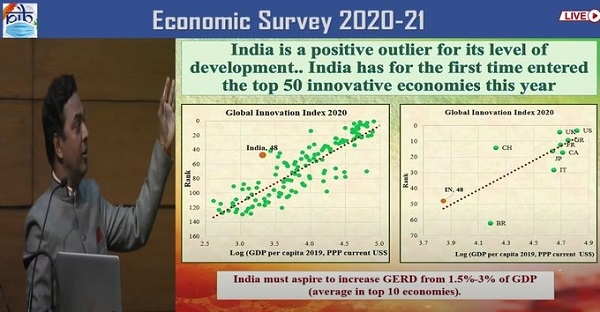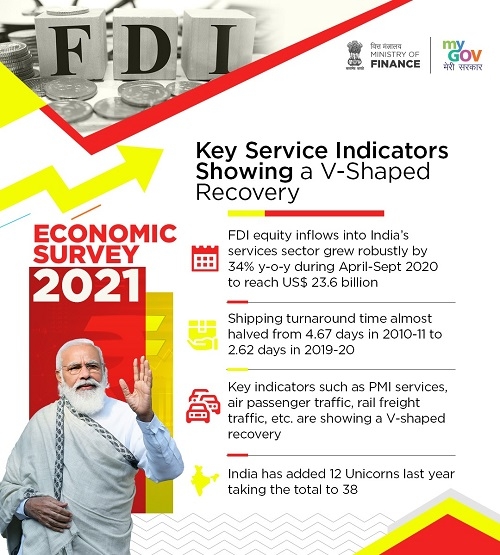Date with Debt? 10 major points made by the Economic Survey
Total Views |
The Economic Survey presented by Finance Minister Nirmala Sitharaman yesterday, strongly argues for a big expansion of government spending, financed by borrowing, blissfully ignoring any whiny protests by international rating agencies over fiscal expansion and worrywarts who warn against crowding out private investment. Like in the previous years, the Economic Survey tries to summarise the state of the Indian economy across various dimensions. Here are ten important points with regard to the economy that the Survey has made.
1. The Survey expects the Indian economy to grow by 11% in real terms adjusted for inflation during 2021-22. This is close to the growth of 11.5% forecast by the International Monetary Fund (IMF). This is good news. A 11% growth from this means that the Indian GDP in 2021-22 is expected to be at ₹149.2 lakh crore, which is just 2.4% more than the GDP of ₹145.7 lakh crore in 2019-20. Hence, what this means is that the pre-covid slowdown of economic growth along with economic contraction post covid, have ensured that the Indian GDP in 2021-22 will be just a tad more than in 2019-20, leading to nearly two years of economic growth being lost. This is a point which needs to be remembered while celebrating the 11% growth forecast by the Survey for 2021-22. Also, in nominal terms, the economy is expected to grow by 15.4% during 2021-22.

2. The gross tax revenue earned by the government during the period April to November 2020 fell by 12.6% to ₹10.26 lakh crore. This isn’t surprising given that other than excise duty, the taxes earned by the government have taken a severe beating, due to the economy contracting. The excise duty collections have gone up because the government has increased the excise duty collected per litre of petrol and diesel, during the course of the year. The gross tax revenue earned during the year is expected to fall well short of the budgeted ₹24.2 lakh crore. A portion of the gross tax revenue earned by the union government is shared with the state governments. This devolution has fallen by 20.7% to ₹3.34 lakh crore between April and November 2020. Clearly, the state governments have been hit harder by the economic contraction.
3. Other than gross tax revenue, the amount of money the government expected to earn through the disinvestment route, by selling its stake in public sector enterprises, has taken major beating this year. Of the targeted ₹2.1 lakh crore, by 20th January, 2021, the government was able to earn only ₹15,220 crore through this route, or around 7.2% of the targeted amount. More than half of this money came by selling shares in Hindustan Aeronautics Limited and Indian Railway Catering and Tourism Corporation Ltd. The Survey puts the blame for this on Covid. While his was true for the first half of the year, the government could clearly have done better during the second half. The stock market went from strength to strength and recently the BSE Sensex, India’s most famous stock market index, even crossed 50,000 points. Given this, it needs to be stated that an opportunity has been missed on this front.

4. Given that the government has been unable to earn as much money as it expected to when it presented the budget for this financial year in February 2020, it is but natural that the fiscal deficit of the government will go up this year. Fiscal deficit is the difference between what a government earns and what it spends during the course of the year. This difference is funded through the government borrowing by issuing bonds. As of January 8, the union government had borrowed a total of ₹10.72 lakh crore, which was 65% more than what it had borrowed in the corresponding period in the previous financial year. The state governments had borrowed a total of ₹5.71 lakh crore during the period, which was 41% more than the previous financial year.
5. Like the Reserve Bank of India did in the Financial Stability Report released earlier this year, the Economic Survey also raises a concern about the disconnect between the level at which the stock prices are and the real economy. As the Survey points out: “While stock markets value the potential future growth, these elevated levels still raise concerns on the disconnect between the financial markets and real sector." Between April and December 2020, the foreign institutional investors have net invested a massive $30 billion in buying Indian stocks, which was five times the amount invested in 2019. This has been one of the main reasons driving the stock market to very high levels, not justified by the future expected earnings of companies.
6. An important point that the Survey makes is that of the Indian economy recovering during the second half of this year. This is primarily happening because in an environment where both corporate and individual spending has taken a backseat, the government has come in as the spender of the last resort. The government consumption in the second half is expected to grow by 17%, after contracting by 3.9% during the first half. On the other hand, private consumption, which forms more than half of the Indian economy is expected to contract by 0.6% in the second half, after having contracted by 18.9% during the first half.

Over and above this, investment in the Indian economy is expected to contract by 0.8% in the second half of the year, against a contraction of 29% in the first half. Clearly, the survey expects things to improve during the second half, but with investment as well as private consumption contracting during the course of the whole year, the ability of the economy to create jobs continues to remain limited.
7. Of the major sectors, the only sector expected to grow this year is agriculture which is expected to grow by 3.4%. As the Survey points out: “The agriculture and allied sectors were the sole bright spot amid the slide in performance of other sectors." The interesting thing is that the share of agriculture as a part of the total gross value added in the economy every year, has been coming down. In 2019-20, it stood at 14.7%. But in 2020-21, this is expected to grow to 16.3%, due to the contraction of other major sectors. This is the first time the sector’s share in the economy will grow, in close to a decade.
8. Some sort of recovery during the second half is also visible in the increased collections of Goods and Services Tax (GST). The monthly GST collections in December 2020 stood at ₹1.15 lakh crore or 12% more than in December 2019. The Survey attributes this increase to “the combined effect of the rapid economic recovery post pandemic and the nation-wide drive against GST evaders and fake bills along with many systemic changes introduced recently, which have led to improved compliance." Over and above this, there might be another reason; the increased formalisation of Indian economy in the aftermath of the covid pandemic, with the shutdown of many small businesses. Hence, while the GST collections may have gone up, many small businesses have been shut-down, destroying jobs in the process. This does not augur well for private consumption in the months to come.
#EconomicSurvey2021 shows Govt contribution to R&D expenditure is 3 times the avg contributed by govts in the top 10 economies #SavingLivesAndLivelihoods #VShapedRecovery (2/5) @FinMinIndia @PIB_India @nsitharamanoffc pic.twitter.com/4fHLLlRtoJ
— Prof. Krishnamurthy V Subramanian (@SubramanianKri) January 29, 2021
9. The impact of covid has also been seen on bank credit growth or the increase in loans given by banks in comparison to the previous year. As of January 1, bank credit growth stood at 6.7%. Since September 2019, bank credit growth has been in single digits. Indeed, this is a reason to worry. In fact, one of the reasons for this is the fact that banks continue to remain undercapitalized. The Survey feels that this might lead to banks leading to zombie companies. Zombie companies are basically companies which are not making enough money to even be able to repay the interest on their loans. As the Survey points out: “Under-capitalized banks may again resort to risk-shifting and zombie lending, thereby severely exacerbating the problem. The adverse impact could then spill over to the real economy through good borrowers and projects being denied credit." This is a reason for worry and needs to be addressed quickly.
10. One of the key economic trends this year has been high inflation. Inflation as measured by the consumer price inflation between April and December 2020 stood at 6.6% in comparison to the previous year. This has been on account of high food inflation of 9.1%. The Survey feels that “supply chain bottlenecks owing to COVID-19 induced disruptions" have been the main cause behind this inflation. As the economy opens up, food inflation has also been coming down and that’s clearly good news.
.


